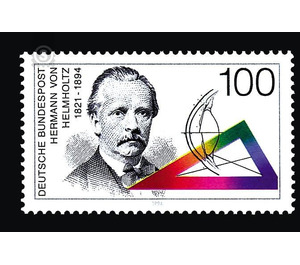100th anniversary of death of Hermann von Helmholz - Germany / Federal Republic of Germany 1994 - 100 Pfennig
Theme: Calender
| Country | Germany / Federal Republic of Germany |
| Issue Date | 1994 |
| Face Value | 100.00 |
| Color | black white |
| Perforation | K 14 |
| Printing Type | combined intaglio and offset printing |
| Stamp Type | Postage stamp |
| Item Type | Stamp |
| Chronological Issue Number | 1625 |
| Chronological Chapter | GER-BRD |
| Michel ID | BRD 1752 |
| SID | 704976 |
| In 37 Wishlists | |
Hermann von Helmholtz, born August 31, 1821 in Potsdam, died September 8, 1894 in Charlottenburg, was one of the naturalists of the 19th century, whose universality shaped the science of their time sustainable. His research activities spanned physiology and medicine, physics, mathematics, music and philosophy. Despite his strong interest in natural sciences Helmholtz studied, especially for financial reasons, medicine. After completing his studies, he worked as a military doctor in Berlin. In investigations of the human metabolism, he came up with the question of the "vitality" of man. The ideas of that time contradicted, according to Helmholtz's understanding of the laws of nature, and he began to study physics and mathematics. In "The Conservation of Power," he wrote down his ideas in 1847, chiefly with the intention of giving an overview of the laws of nature from the point of view of a physiologist. In it he formulated one of the fundamental laws of physics: the conservation of energy. Independently of him, Joule and Mayer had already done so, but only Helmholtz gave this law a mathematical formulation and interpreted it more generally. Connected with this generalized concept of energy was the realization that mechanical work, electricity and heat are different forms of energy that can be transformed into each other. His research and teaching activities as Professor of Physiology in Königsberg (1848-1855), Bonn (1855-1858) and Heidelberg repeatedly brought Helmholtz into contact with problems of physiological optics and acoustics and led to intensive studies of the physical fundamentals. His two major publications on these subjects, "Manual of Physiological Optics" and "Theory of Sound Sensations," in which he provided a comprehensive analysis of visual and auditory processes, are standard works to this day. In his experimental investigations of the anatomical structure of the eye and its optical properties, he was the first to use an ophthalmoscope (1851). Thus, he was able to observe the human retina, and thus became the founder of scientific ophthalmology. His work in the field of sensory perception also dealt with the transmission of sensations through the nerves (eg, measuring the rate of propagation of nerve excitations) and the processing of sensory impressions in the brain. Only during his last twenty years did Helmholtz turn his attention to physics. After his appointment as Professor of Physics at the University of Berlin in 1871, he worked mainly in the field of electricity. From the laboratory led by him famous physicists such as Ludwig Boltzmann and Heinrich Hertz emerged. Almost all branches of physics and physiology owe him significant progress. He not only worked in the experimental field, but also dealt with the current issues of mathematics and theoretical physics. In recognition of his life's work, he was appointed in 1888 President of the newly founded Physical-Technical Imperial Institute in Berlin. (Text: Andrea Bock, Physics Institute of the University of Bonn)
| Condition | Name | In Stock | Price | Price + Shipping | Store | |
|---|---|---|---|---|---|---|
 | Used | 100th anniversary of death of Hermann von Helmholz - Germany / Federal Republic of Germany 1994 - 100 Pfennig | 1 | US $0.226 | N/A |  Utestamps (0) Utestamps (0)Request a Shipping Quote Minimum Lot Average US $1.93 |
 | Unmounted Mint ** | 100th anniversary of death of Hermann von Helmholz - Germany / Federal Republic of Germany 1994 - 100 Pfennig | 6 | US $0.862 | US $4.08 |  FILATELIELOKET (0) FILATELIELOKET (0)Shipping US $3.22 Minimum Order US $2.69 |


